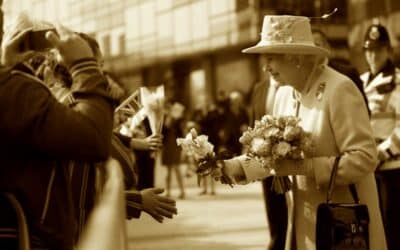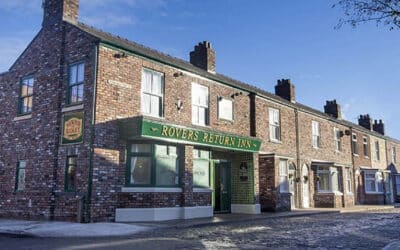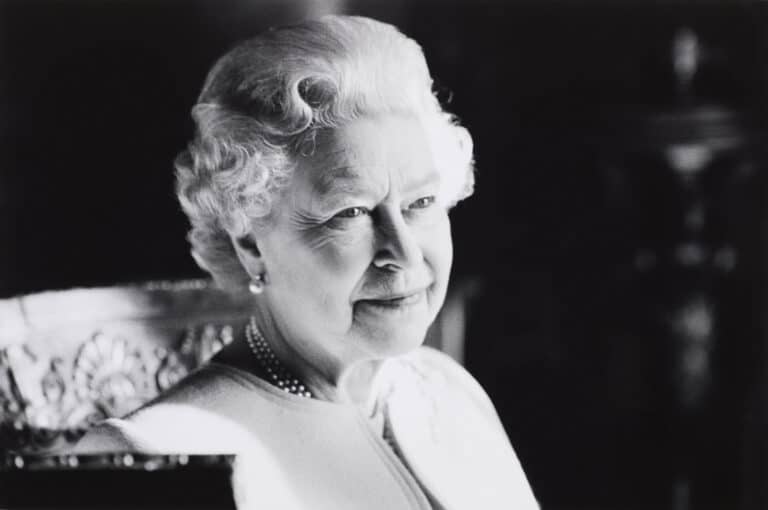From delivering her annual Christmas message to the nation, a tradition she began in 1957 and continued almost every year until her death last week, to starring alongside James Bond (Daniel Craig) during Danny Boyle’s critically acclaimed London 2012 Olympic Opening Ceremony, Queen Elizabeth II could reasonably be described as the UK’s, and probably the world’s, first “TV Queen.”
That’s perhaps not entirely surprising. The Queen did, after all, live and reign during an era that saw TV develop from the experimental oddity John Logie Baird presented to the world in 1927, to an increasingly popular, though still primitive, black and white living room staple in the 50s and 60s, to the all-conquering medium of information and entertainment of the late 20th century and the connected visual library we know today.
When Elizabeth came to the throne in 1952, it was still illegal to depict a living monarch on either stage or screen – or specifically on the sole BBC channel that was the only one audiences had to watch at the time. ITV would not come into being until 1958, with BBC 2 following a further six years later.
Elizabeth seemed to quickly recognise the potential of this newfangled device, however. Her coronation in 1953 was the first to be televised, and by 1957 she had decided that the new medium was a better place for her annual Christmas message than the radio, where her grandfather George V had first created the annual tradition in 1932.
The Queen became a master of this festive missive, though when we say “almost” every year it’s with good reason. In 1969, she did not deliver the traditional televised speech, opting to send a written communication instead.
This was the same year as the infamous Royal Family documentary which, it would be fair to say, was not a universal success. The fly-on-the-wall doc followed the key Royals as they went about their daily lives, but it came in for its fair share of criticism for demystifying the institution, and even making viewers immune to the Royals’ charm through over-familiarity.
Sir David Attenborough, then controller of BBC 2, and a man who would go on to be director-in-residence of The Queen’s increasingly slick Christmas messages in later years, warned that the documentary risked “killing” the institution of the monarchy.
Traditionally, The Queen is not in the business of offering criticism of the biggest TV hits of the day, but it’s widely accepted that she was not a fan of Royal Family, and asked for it never to be shown again following its run on the BBC. It is also widely held that this feeling of TV saturation was the cause of her decision to forego the usual TV Christmas message that year.
From that point on, The Queen seemed to adopt a “less-is-more” approach for many years, restricting her speaking roles on TV. A second documentary was made in 1992, but this time around much tighter restrictions were placed on the filmmakers, resulting in producer Edward Mirzoeff complaining that making Royal documentaries was actually impossible as a serious journalist.
That aside, The Queen largely restricted her speaking roles on TV for several years to big ticket events – historical events such as the outbreak of the Gulf War, the death of key Royals, and an early-pandemic address that managed to strike a tone between respectfully cautious and defiantly strong that politicians on all sides had utterly failed to muster.
Despite withdrawing from the TV limelight, Royal Family wouldn’t be the last time the monarch’s relationship with TV would be strained. The Queen, wisely, didn’t take part in the much-mocked 1987 The Grand Tournament, better known as It’s a Royal Knockout. The show, based on the popular, wacky 80s game show It’s a Knockout, found her sons, Princes Edward and Andrew, alongside Princess Anne and Sarah Ferguson, then Duchess of York, leading teams of celebrities to compete in a series of foam-filled and inflatable challenges, part-charity fundraiser and part-contrived effort to launch Edward’s TV production career.
The show was excruciating to watch, and Ben Pimlott quoted an anonymous friend in his 1996 biography The Queen as saying: “It was a terrible mistake. She was against it. But one of her faults is that she can’t say no [to her children].”
By the later years of her reign, however, The Queen seemed to have made her peace with the cameras. Her appearance with Bond, ending with a stunt double parachuting into the Olympic stadium on opening night in 2012, was a stroke of comic genius, and very much The Queen’s idea.
The skit’s writer, Frank Cottrell-Boyce, revealed to Radio 4 last Friday that the team behind the sketch had expected a double to film all of The Queen’s parts, only to discover on arriving at Buckingham Palace to receive seek approval for the sketch that not only was it approved, but The Queen would be playing herself (albeit not for the skydiving sequence).
Cottrell-Boyce was on writing duty again for The Queen’s very last speaking role on screen, and it’s perhaps appropriate for a woman who displayed an impressive sense of humour despite the extreme seriousness usually required of her role that it should have been alongside an animated, refugee bear – the Ben Whishaw-voiced Paddington – as part of her Platinum Jubilee celebrations.
Her final words in that role were words that many across the nation may well wish to echo back at her over the next few days as the nation mourns: “Thank you very much.”












